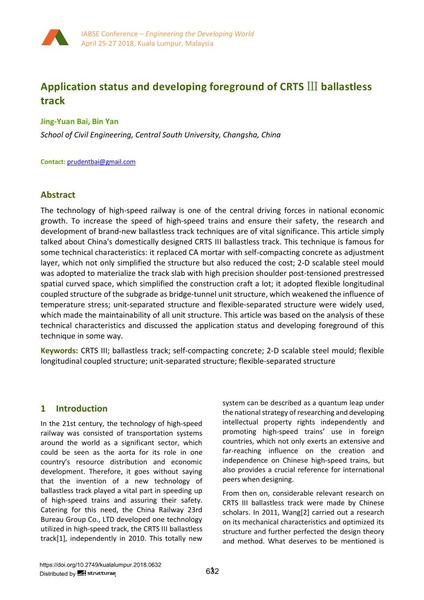Application status and developing foreground of CRTS Ⅲ ballastless track

|
|
|||||||||||
Détails bibliographiques
| Auteur(s): |
Bai Jing-Yuan
(School of Civil Engineering, Central South University, Changsha, China)
Bin Yan (School of Civil Engineering, Central South University, Changsha, China) |
||||
|---|---|---|---|---|---|
| Médium: | papier de conférence | ||||
| Langue(s): | anglais | ||||
| Conférence: | IABSE Conference: Engineering the Developing World, Kuala Lumpur, Malaysia, 25-27 April 2018 | ||||
| Publié dans: | IABSE Conference Kuala Lumpur 2018 | ||||
|
|||||
| Page(s): | 632-636 | ||||
| Nombre total de pages (du PDF): | 5 | ||||
| DOI: | 10.2749/kualalumpur.2018.0632 | ||||
| Abstrait: |
The technology of high-speed railway is one of the central driving forces in national economic growth. To increase the speed of high-speed trains and ensure their safety, the research and development of brand-new ballastless track techniques are of vital significance. This article simply talked about China's domestically designed CRTS III ballastless track. This technique is famous for some technical characteristics: it replaced CA mortar with self-compacting concrete as adjustment layer, which not only simplified the structure but also reduced the cost; 2-D scalable steel mould was adopted to materialize the track slab with high precision shoulder post-tensioned prestressed spatial curved space, which simplified the construction craft a lot; it adopted flexible longitudinal coupled structure of the subgrade as bridge-tunnel unit structure, which weakened the influence of temperature stress; unit-separated structure and flexible-separated structure were widely used, which made the maintainability of all unit structure. This article was based on the analysis of these technical characteristics and discussed the application status and developing foreground of this technique in some way. |
||||
